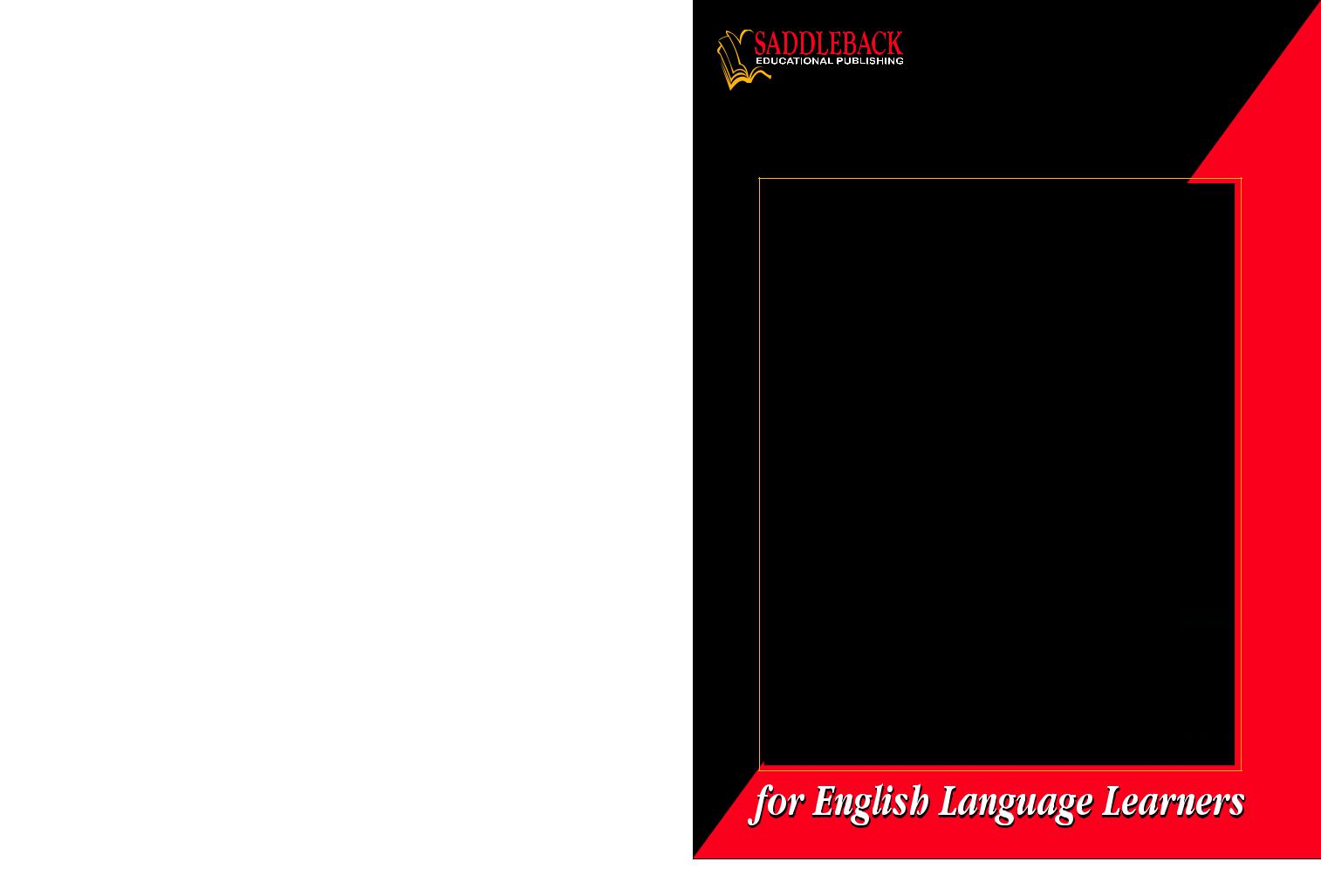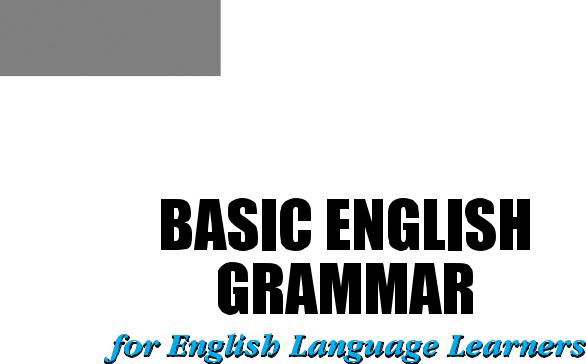
- •Note to the Student from the Publisher
- •1 Nouns
- •2 Pronouns
- •3 Adjectives
- •4 Determiners
- •5 Verbs and Tenses
- •6 Auxiliary Verbs
- •7 Adverbs and Adverb Phrases
- •8 Prepositions and Prepositional Phrases
- •9 Conjunctions
- •10 Sentences
- •11 Direct and Indirect Speech
- •12 Punctuation
- •A List of Irregular Verbs

BASIC ENGLISHENGLISH
GRAMMARAMMAR
BookBook
22

Book
2
HowardSargeant

Three Watson
Irvine, CA 92618-2767
Web site: www.sdlback.com
First published in the United States by Saddleback Educational Publishing, 3 Watson, Irvine, CA 92618 by arrangement with Learners Publishing Pte Ltd, Singapore
Copyright ©2007 by Saddleback Educational Publishing. All rights reserved. No part of this book may be reproduced in any form or by any means, electronic or mechanical, including photocopying, recording, or by any information storage and retrieval system, without the written permission of the publisher.
ISBN 1-59905-203-2
Printed in the United States of America 13 12 11 10 09 08 07

Note to the Student from the Publisher
Grammar is a very old field of study. Did you know that the sentence was first divided into subject and verb by Plato, the famed philosopher from ancient Greece? That was about 2,400 years ago! Ever since then, students all over the world have found it worthwhile to study the structure of words and sentences. Why? Because skill in speaking and writing is the hallmark of all educated people.
Lesson by lesson, this book provides basic instruction in the eight parts of speech—nouns, pronouns, verbs, adjectives, adverbs, prepositions, conjunctions, and interjections—as well as the standard patterns of English sentences.
All students of English, be they native speakers or those who are studying English as a second language, will profit from the fundamental introduction and review of grammar provided by SADDLEBACK'S BASIC ENGLISH GRAMMAR 1 and 2. Helpful marginal notes throughout the books have been provided to reinforce existing skills and call attention to common problem areas.
We wish you every success in your pursuit of English proficiency.

What you’ll find in this book
1
2
3
4
Nouns |
7–23 |
Common Nouns |
7 |
Proper Nouns |
8 |
Singular Nouns |
11 |
Plural Nouns |
11 |
Collective Nouns |
17 |
Masculine and Feminine Nouns |
20 |
The Possessive Form of Nouns |
22 |
Pronouns |
24–31 |
Personal Pronouns |
24 |
Reflexive Pronouns |
26 |
Possessive Pronouns |
27 |
Demonstrative Pronouns |
27 |
Interrogative Pronouns |
28 |
Indefinite Pronouns |
28 |
Adjectives |
32–43 |
Kinds of Adjectives |
32 |
The Order of Adjectives |
33 |
Adjective Endings |
35 |
Describing What Something Is Made of |
37 |
The Comparison of Adjectives |
39 |
Adjective Phrases |
42 |
Determiners |
44–51 |
The Articles |
44 |
Using Nouns without Articles |
45 |
Demonstrative Determiners |
46 |
Quantifying Determiners |
47 |
Interrogative Determiners |
49 |
Possessive Determiners |
49 |
Numbers |
50 |
Using Determiners Together |
50 |

5
6
7
8
Verbs and Tenses |
52–87 |
Subject and Verb Agreement |
52 |
Transitive and Intransitive Verbs |
55 |
The Simple Present Tense |
58 |
am, is and are |
59 |
there is and there are |
60 |
The Present Progressive Tense |
63 |
The Simple Past Tense |
65 |
was and were |
66 |
Irregular Verbs |
67 |
The Past Progressive Tense |
70 |
have, has and had |
71 |
The Present Perfect Tense |
73 |
Irregular Past Participles |
73 |
The Future Tense |
77 |
do, does and did |
80 |
The Infinitive |
83 |
The Imperative Form of Verbs |
84 |
Gerunds |
85 |
Auxiliary Verbs |
88–94 |
can and could |
88 |
will and would |
89 |
shall and should |
89 |
ought to |
90 |
must |
90 |
may and might |
90 |
Verb Phrases |
91 |
Adverbs and Adverb Phrases |
95–100 |
Adverbs of Manner |
95 |
Adverbs of Time |
96 |
Adverbs of Place |
96 |
Adverbs of Frequency |
97 |
Adverbs of Duration |
97 |
Adverbs of Emphasis |
98 |
Prepositions and Prepositional Phrases |
101–108 |
Preposition or Adverb? |
101 |
Prepositions of Place |
102 |
Prepositions of Time |
102 |
Prepositions of Direction |
103 |
Prepositions with Special Uses |
103 |
Prepositions with Adjectives, Verbs or Nouns |
105 |

9
10
11
12
Conjunctions |
109–117 |
and, but and or |
109 |
Conjunctions Linking Phrases |
110 |
Conjunctions with Lists |
110 |
Conjunctions That Join Sentences |
111 |
Other Words for and |
111 |
Other Words for but |
112 |
Other Words for or |
112 |
Conjunctions of Time |
113 |
Conjunctions of Place |
113 |
Conjunctions of Reason |
114 |
Conjunctions of Purpose |
114 |
Sentences |
118–133 |
Four Kinds of Sentence |
118 |
Sentences with Objects |
119 |
Verbs with Two Objects |
120 |
Verbs with No Object |
120 |
Simple Sentences |
123 |
Compound Sentences |
123 |
Conditional Sentences |
124 |
Positive and Negative Sentences |
124 |
Questions |
128 |
Question Tags |
130 |
Direct and Indirect Speech |
134–139 |
Direct Speech |
134 |
Indirect Speech |
134 |
Indirect Commands |
135 |
Indirect Questions |
136 |
Punctuation |
140–148 |
Punctuation Marks: period, comma, question mark, |
|
exclamation point, apostrophe, quotation marks, colon |
140 |
Capital Letter |
144 |
A List of Irregular Verbs |
149–152 |
